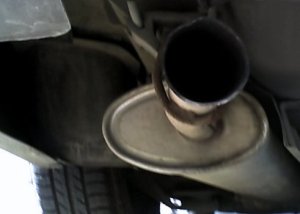
When people think of their exhaust system, they think of the muffler and tail pipe. This is only part of the system. Your vehicle’s exhaust system is made up of a serious of chambers and pipes that start at the engine and end at the tail pipe. Each component plays a role in protecting you and the environment from harmful gases, quiets the noise from the combustion process and makes your car run efficiently.
The most critical function of the exhaust system is to control emissions. When an exhaust system isn’t functioning properly, these noxious gases can enter the passenger compartment of your vehicle posing a hazard to you and others. A malfunctioning exhaust system will also emit more pollution into the environment.
If you’ve ever had your “Check Engine” light come on when it was time to get your car inspected, you know that, in New Jersey, there are strict emission requirements for vehicles. When the Check Engine light is illimunated it is indicating a problem with the car’s emission system. There could be any number of reasons why the on-board diagnostic system and engine control are sending the “Check Engine” message. It could be as simple as a loose gas cap or faulty oxygen sensor to a more complicated issue like a blown head gasket or a catalytic converter that needs to be replaced. When the light comes on, it’s best to bring it in to have the problem diagnosed and corrected right away. Failure to do so can lead to extra strain on your vehicle which will eventually cause total failure of certain components like the catalytic converter.
What are the parts that make up an exhaust system?
There are five main parts to a typical exhaust system. Here’s what they are and what they do:
- Exhaust Manifold – This component is attached to the engine at the cylinder head. Its job is to collect the exhaust gases produced during the combustion process and deliver them to the exhaust pipe.
- Oxygen Sensor – This part measures the oxygen level in the exhaust and sends a signal to the vehicle’s computer so it can determine whether it needs to send more or less fuel to the combustion chambers.
- Exhaust Pipes – They carry the exhaust through the entire system starting at the the front of the engine and ending at the tail pipe.
- Catalytic Converter – The catalytic converter has the job of converting the harmful gases, like carbon monoxide, into carbon dioxide and water vapor.
- Muffler – This “silences” the loud noises that are produced during combustion.
How do you know if you need an exhaust system repair?
Because most of the system is exposed to the elements, like road salts, the biggest problem your vehicle’s exhaust system faces is rust and corrosion. To help minimize the effects of salt corrosion, it’s a good idea to hose the underside of your vehicle every few weeks in the winter months. If you notice excessive rust or holes, have your system checked. Beyond that, here are some signs to look for to alert you that your exhaust system needs repair:
- Smelling Fumes – If you smell any type of fumes in the passenger compartment, schedule an appointment with Country Road Automotive in Lincoln Park, New Jersey. Until you can bring your vehicle in for an exhaust system repair, it’s a good idea to drive with the windows down to minimize the fumes you inhale.
- Hearing Hissing & Popping Noises – Noises from the exhaust system are a good indicator there is a leak in the muffler.
- Noticing a Decrease in Fuel Efficiency – This could indicate a malfunctioning oxygen sensor.
The best way to make sure your vehicle’s exhaust system is doing its job is to have it inspected from time to time and to take care of minor problems before they become major exhaust system repair issues. The mechanics at Country Road Automotive in Lincoln Park, NJ, perform a courtesy inspection each time your vehicle is in for maintenance. If we notice a problem, we’ll let you know so you can have it taken care of right away. Give us a call today to schedule your appointment or click here to schedule on-line right now.

